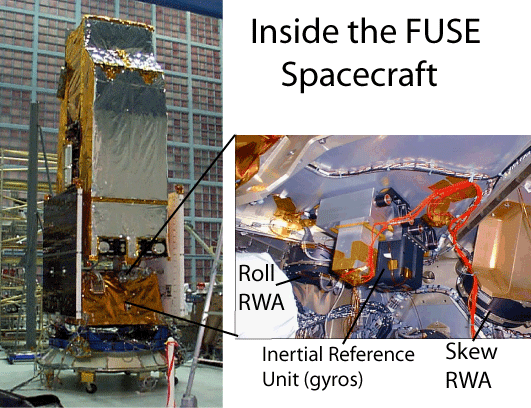

Mission Status Report #62 Star Date: Oct. 29, 2002
FUSE Prepares for the FutureCaption: The FUSE satellite is shown at left, at NASA/GSFC in August 1998. The spacecraft is the gold box toward the bottom and the science payload (telescopes and spectrographs) make up the silver and gold structure above. The solar panels are shown in the "stow" position. The enlargement at right shows a peek inside the spacecraft box, which is mostly empty space! The two working reaction wheels (marked RWA) are indicated, as is one of the gyro packages called an "Inertial Reference Unit." (Figure courtesy JHU.)
Operations with FUSE continue to proceed very smoothly using using the current control system that combines the two operating Reaction Wheel Assemblies and the Magnetic Torquer Bars. (See earlier reports for details.) We are just past the mid-point of Cycle 3, with the extended mission phase set to begin in the spring of 2003. Over the last two months several tests have been carried out to help us extend FUSE's ability to access targets all over the sky. At this point, sky coverage is somewhat over 75%, and the techniques that have been tested should permit us to increase this even more. Another element of the control system involves the gyroscopes. FUSE carries a total of six gyros, mounted in two packages of three. (Each package is called an Inertial Reference Unit, or IRU.) The gyros are FUSE operated with IRU-A for about the first two years (May 2001) when the roll axis gyro failed. Operations were switched to IRU-B and have continued smoothly since then. However, there is no longer any redundancy on the roll axis. What happens if the roll gyro in IRU-B fails, or if other gyros start to fail with age? We want to be able to keep operating FUSE! With an eye toward longer term operations, the team at JHU is working very hard with its contractors to prepare and test a revised set of flight software to be uplinked to the spacecraft in early 2003. This operation will be somewhat similar to performing a "brain transplant" on FUSE! This new software will allow FUSE to be controlled and point stably even if some of the gyroscopes onboard begin to fail over time. The gyroscopes provide the control system with "drift rate" information. This is particularly important during slews (the time periods where we are moving from one target position to the next). If one or more gyros fail, we no longer have detailed information on drift rates in a given axis of motion, and the slews become less accurate. The new flight software will overcome this problem by deriving drift rate information from other sources, including an improved "dynamics" model of the spacecraft itself and other sensors on board. One of the reasons this change is quite tricky is that the updates involve all three computers on FUSE and the way they talk to each other. (I guess you could say we are transplanting the entire nervous system, not just the brain!) The Attitude Control System computer on the spacecraft has to work with the Instrument Data System computer (on the science instrument) and the Fine Error Sensor computer on the guide camera. One of the tricks is to have the FES computer do more work on its own, processing images quickly and locking onto stars faster before they drift away. Once the FES is locked onto stars, the drifts can be taken out and the target acquisitions can proceed. When the system is in place and tested, it will allow FUSE operations to continue even if NO gyros are operational (although it continues to use whatever gyros are available at any given time to improve performance). In future updates, I will keep you posted on our progress. On another front, October 10, 2002, was the closing date for the NASA Cycle 4 Call for Proposals. This will be the first observing cycle in the FUSE "Extended Mission." An excellent batch of proposals was received and will be reviewed by NASA, with a portion of them being selected for observations over the coming year. This is always an exciting and challenging time for the project, because there are always more "good ideas" than we can support, and picking the "best" takes time and effort. Good luck to those who proposed! Results should be announced in late-January 2003.
Reported by: Bill Blair, Chief of Observatory Operations
|
